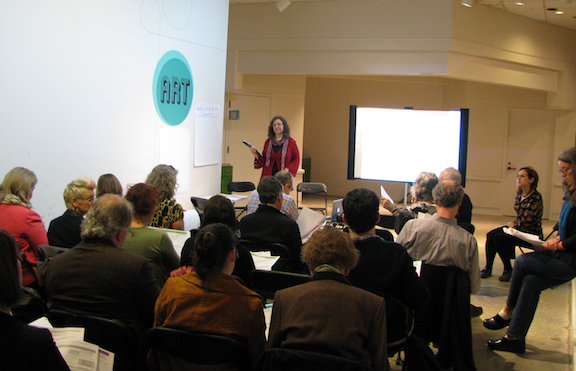Photo by Steph Guinan
The concept that is driving the Buncombe Cultural Alliance’s mission is collective impact. It’s about shifting from a scarcity mindset where everyone is competing for the same resources to a collaboration model based on the premise that it’s possible to grow the pool of available resources by working together, say organizers.
The BCA was one of the most lauded outcomes from last year’s Creative Sector Summit. One year later, the leadership team hosted a three-hour focus group March 22 at the 2014 Creative Sector Summit to share their progress and solicit feedback on a strategy draft.
Identifying the current plan as a jumping-off point, Executive Director of the Asheville Area Arts Council Kitty Love stated, “This is the compendium of knowledge to date.” With an eye towards developing a shared economic solution, Love noted that currently, “our sectors are fragmented,” and it’s to everyone’s benefit for local arts stakeholders to collaborate. Love stated that the role of the Arts Council is to “serve as a backbone of the organization” providing infrastructure and logistics support.
The strategy draft is framed around five key areas of focus: a thriving arts and culture sector, vibrant places, arts advocacy, quality of life and education as the future of the arts. The stakeholders meeting looked at each of these goals in brief presentations followed by breakout discussion sessions.
Brenda Mills, Economic Development Specialist for the City of Asheville, led a conversation about the first mission point, Thriving Arts and Culture, which took a wide-range look across sectors of nonprofit, business and government. This inventory process is a critical step in identifying the components in our cultural community and the interconnections.
When Janelle Wienke of Handmade in America presented on the mission point, Vibrant Places, she stated, “If we create high visibility for the arts, we will have high participation in the arts.” It is hoped that through better positioning, Asheville can become competitive for receiving grant funding in creative placemaking. It was discussed that creative placemaking programs are about the bigger picture of Asheville, but also about honoring that each different neighborhood has different goals and personalities.
The issue of Arts Advocacy was addressed by Gwynne Rukenbrod of Asheville’s Public Art and Cultural Commission who posed the question: “how can we think outside of traditional advocacy?” The expanded idea of advocacy goes beyond the typical organizational lobbying and sees value in artists attending city council meetings so as to give a voice to a growing sector of the community. Because of the inherent difficulty in quantifying the monetary value of the arts in the community, it’s even more important to advocate for the arts. “We’re going to lose our niche as an arts city if we don’t cultivate it,” said Rukenbrod. She premised that the ultimate goal is to secure additional arts funding, with one possible solution being an alcohol and tobacco tax which could provide about $6 million annually in arts funding.
David Starkey of the Asheville Lyric Opera presented on Quality of Life and addressed the need to quantify, clarify and define an important concept that is wrapped up in a widely used catch phrase. Barbara Benisch, a local resident and management consultant stated, “the richness of our community needs to be fully explored and expressed.”
Stephanie Moore, Executive Director of the Center for Craft Creativity and Design presented on Education and the Future of the Arts. This inclusive view of education looked at kindergarten through higher education in addition to wider community learning opportunities. Speaking of the acronym STEM which stands for science, technology, education and mathematics, Barbara Benish explained, “We believe that STEM is missing the ‘A’ and should be STEAM,” referring to the arts as a way to grow creativity and problem solving skills.
This meeting is one of the first steps to solicit feedback and add additional voices into the dialogue about how the county’s cultural economy can grow. “We want people to be joining the alliance,” said consultant Tracy Kunkler. BCA plans to set up a mailing list for interested community members to stay informed and participate in future town-hall style meetings.
David Starkey said, “My entire 20-year career has been about eliminating walls in my art form, opera often being seen as less accessible than other media.” In many ways, the Buncombe Cultural Alliance is working to break down the walls and barriers between arts stakeholders so that the creative economy can become stronger by working together, he said.
For more information about the Buncombe Cultural Alliance, visit their website or email Kitty Love at kitty@ashevillearts.com.






Before you comment
The comments section is here to provide a platform for civil dialogue on the issues we face together as a local community. Xpress is committed to offering this platform for all voices, but when the tone of the discussion gets nasty or strays off topic, we believe many people choose not to participate. Xpress editors are determined to moderate comments to ensure a constructive interchange is maintained. All comments judged not to be in keeping with the spirit of civil discourse will be removed and repeat violators will be banned. See here for our terms of service. Thank you for being part of this effort to promote respectful discussion.